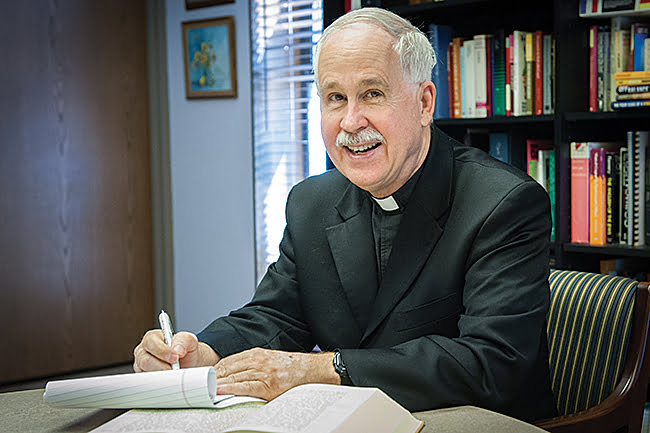
Father Mike Stubbs is the pastor of Holy Cross Parish in Overland Park and has a degree in Scripture from Harvard University.
by Father Mike Stubbs
In our day and age, a cornerstone often figures as a decorative feature of a building.
An inscription on it may include the year when the building was constructed and the name of the building.
Sometimes, a time capsule is placed inside the cornerstone, containing perhaps newspapers of the day when the cornerstone was laid or other artifacts typical of the period.
The ceremonial laying of the cornerstone often constitutes an important beginning moment in the construction process.
In contrast to that, in ancient times, a cornerstone served a very practical purpose. It set the course for the entire building. The cornerstone was the first stone to be placed in the construction process.
The other stones lined up with it. In that sense, the cornerstone determined the position of the building. It formed part of the foundation.
The laying of the cornerstone often included the sacrifice of an animal, or even of a human being. The sacrificial victim was buried underneath the cornerstone, with the belief that its blood would give strength and stability to the building.
In the case of a human sacrifice, the angry ghost would haunt the place and protect it from enemies.
“The stone that the builders rejected has become the cornerstone” (Mt 21: 42).
We hear these words in Sunday’s Gospel reading. Jesus says them in the context of a parable that he tells in which the son of the landowner is rejected by the tenants. In fact, they put him to death.
We identify the son in the parable with Jesus himself, who is also rejected and put to death. Consequently, we also identify Jesus with the stone that the builders rejected that has become the cornerstone.
This is not the only place in Scripture where this identification is made. This verse, which is a quotation of Ps 118:22, also appears in 1 Pt 2:7 and Acts 4:11.
In every case, the cornerstone corresponds to Jesus. The verse played a significant role for the early Christians in understanding the meaning of Jesus’ rejection by the authorities and his death at their hands.
A cornerstone implies that other stones will follow in the construction of a building. The First Letter of Peter builds upon the metaphor of Jesus as the cornerstone to describe individual Christians as additional stones, joined together to form the church.
Our lives line up with Jesus, in order to build the church, “built upon the foundation of the apostles and prophets, with Christ Jesus himself as the capstone. Through him the whole structure is held together and grows into a temple sacred to the Lord” (Eph 2:20-21).

